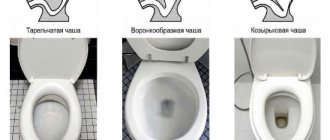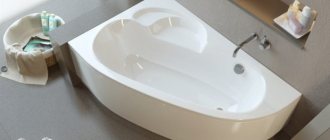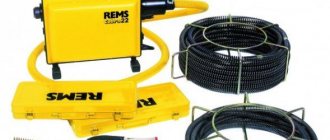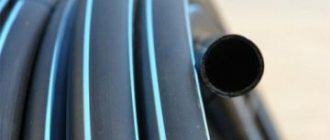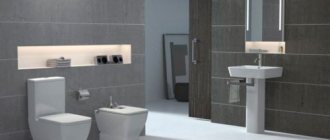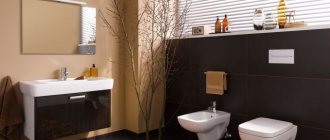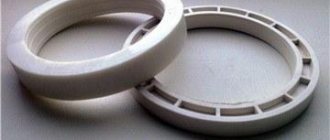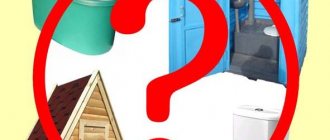An integral part of a modern home is a sanitary unit. A bathtub, washbasin, shower stall, bidet, and toilet have long become familiar and necessary household items.
Often the area of the toilet room does not allow the installation of plumbing fixtures, without focusing on its dimensions and area. And in large toilets of new private houses, the dimensions of all installed plumbing also need to be taken into account in order to link all the interior details of the toilet room into a single design ensemble, beautiful and comfortable.
How to choose?
The toilet barrel is selected according to the following criteria:
- method of attachment to the toilet;
- form. Along with regular tanks, flat tanks are sold - with reduced depth, but increased height and width;
- water connection. There are two options: bottom and side. In the first case, when filling the tank, no murmur is heard, but more complex and expensive fittings are required;
- drain hole position. Relevant when attaching directly to the toilet (the most common option): the holes in the tank and bowl must match;
- drain mechanism device;
- color.
The cost of the product is also important. Tanks of the same class can be sold with a significant difference in price, because one of them is produced by a well-known brand, and the second is not yet promoted.
Choosing a cistern
When installing a drain tank, a shut-off valve must be installed to shut off the water, since the shut-off device should be inspected annually
The valve is the most important and complex part of the toilet kit. Its task is to ensure complete and quick flushing of the contents of the toilet bowl, and then automatically fill with water to a certain volume
This device is often sold complete with a toilet.
Quiet operation is one of the main signs of the quality of the drain tank
Pay attention to this - a strong noise when filling the drain tank with water indicates incorrect installation or the presence of a manufacturing defect in the product. To insure against this, it is better to purchase toilets in highly specialized stores, where you can get a guarantee on them
When choosing a flush container, look at the type of tank and its location relative to the toilet. There are samples with both a separate location and a joint one. A separate arrangement usually involves a suspended tank, which is attached to a specially designed frame. The container can be placed at any height according to your wishes. In joint models, it is mounted to the toilet (from above) and can be attached or solid.
Kinds
Structurally, toilet tanks are divided into several types.
"Compact"
This is the most popular option. The tank is installed directly on the toilet, for which the latter has a shelf on the back with mounting holes.
Compact toilet
Built-in
Such systems are more difficult to install than “compact” systems, but due to a number of advantages, more and more users prefer them. The product is installed in a special frame (installation) close to the wall, after which a plasterboard partition (false wall) is mounted at the level of its front wall. As a result, only the toilet remains visible.
Usually a hanging type bowl is used - it is also attached to the installation.
Advantages of an embedded solution:
- the room looks neat;
- the entire floor is accessible for cleaning;
- The sound of water in the tank behind the partition is not heard.
The flush button is located on the front wall. Through the hole for it, access to the fittings for repair is provided.
Along with wall-hung toilets, floor-mounted toilets are also produced - for people who are afraid to sit on the wall-hung version. These fears are not justified, since the mount can withstand weights of up to 400 kg, but some still prefer the floor-mounted option. Cleaning the floor around such a toilet is still easier than with a regular one.
Top mounted
It is installed almost under the ceiling and connected to the toilet with a pipe. This option is outdated, but in some places it is still found: in public toilets, dormitories, etc. Such designs are also used in interiors decorated in “retro” or “loft” styles.
The advantage of the solution: water is supplied to the bowl with strong pressure, which ensures high quality flushing.
There are more disadvantages:
- the drainage of water is accompanied by loud noise;
- the drain mechanism is difficult to access;
- The design is aesthetically inferior to the “compact”.
How many liters are in the toilet cistern?
The volume of the drain tank is influenced by several basic parameters. And if previously the size of a product was strictly regulated by GOST, now on store shelves there are products of a wide variety of shapes and sizes. So, tanks for draining water can be:
- Mounted. These are old models that can only be found in communal apartments. The tank was made of cast iron, after which it was fixed to the ceiling of the bathroom. Despite the material used, the device was not of high quality or reliability.
- Plastic. They replaced cast iron ones. These are inexpensive models. But the cost directly affects the quality of the tank. Products often fail and require replacement. Therefore they are not in great demand.
- Ceramic, porcelain. The most popular options. The product is mounted directly on the base of the toilet. The tank is practical and has an attractive appearance.
- Polypropylene. A more modern version of a plastic product. The walls of the device are thicker, so it lasts longer. Usually it is mounted on the wall, after which it is “hidden” using decorative panels.
If the shape and material of manufacture vary, then the remaining structural elements remain unchanged. This greatly facilitates independent repairs if necessary. So, the tank consists of the following elements:
- water collection and drainage mechanism;
- valve for water intake.
The size of the tank itself is individual and depends on the manufacturer. So, according to the old GOST, at least six liters of water should be placed in a standard size drain tank.
Containers of various sizes are now available for sale. For example, you can find larger tanks with a capacity of 10 liters. As a rule, they are equipped with two buttons, allowing you to use only half the volume at a time.
Reference! The water drain tank was invented in 1777 by London watchmaker Alexander Cumming.
Drain mechanism device
The tank fittings include two components:
- water supply valve;
- flush mechanism for flushing water into the toilet.
The fittings can be separate or combined.
Separate fittings
This is the most common option.
Both components are not connected to each other. At the entrance to the tank, a valve with a membrane is installed, connected to a lever with a float at the end. When the water rises to the desired level, the float will be at the same level and the membrane will block the flow area of the valve. The drainage mechanism is a vertical rod with a bulb valve at the bottom.
By lifting the rod by the handle (outdated version), the user removes the bulb from the saddle and opens the drain hole. In modern models, this requires pressing the button at the top. The most practical version of the drain mechanism has a double button: one part empties the tank only half, the second completely.
The bulb valve is made of buoyant material, therefore, after being removed from the seat, it is held in the body of water and does not block the drain hole. After the tank is emptied, it falls back onto the saddle and, when the tank is filled, remains in this position, since the water presses on it only from above.
Advantages of the solution:
- low cost;
- ease of adjustment;
- cheap repairs: if damaged, only the failed component is replaced.
Combined reinforcement
This is a more expensive option, used in luxury plumbing fixtures. Both components are combined into one system.
The advantage is significant reliability. Disadvantages: high cost both in purchase and in repair - if it breaks down, you have to replace the entire complex. The design of the fittings depends on the method of supplying water to the tank - from the side or from below.
But the adjustment of both options is carried out almost identically.
Standard volumes and mechanisms
Now among the standard sizes of tanks you can find volumes from 6 to 10 liters. In some cases, you can find larger options on the shelves, but they are not economical.
Modern models of tanks are equipped not only with double buttons for flushing liquid and solid sewage, but also even with two separate tanks that differ in volume. But experts have proven that only 6 liters of water are enough to send waste to the sewer.
As for the mechanisms, there is not much variety here. Most often, modern apartments use automatic systems that only require pressing a button. Public institutions are now installing flushing systems that don’t even require pressing and turn on when a person moves away from the toilet. This solution also improves hygiene.
How are shut-off and drain valves adjusted?
If the tank and fittings set were purchased separately, the drain and shut-off valves require adjustment: the user determines the volume of water entering the container and the installation height of the drain valve.
Adjusting the Float Stop Valve
The products are available in two versions:
- with metal lever for float . To increase the volume of incoming water, it is bent so that the float is higher. To reduce the amount of liquid, do the opposite: bend the lever so that the float is lower;
- with plastic lever for float . This lever does not bend. The position of the float is adjusted with a special screw.
Usually inside the tank there is a mark for the optimal water level - you should follow it.
Sometimes it is not possible to adjust the filling level of the tank by moving the float; possible reasons:
- the shut-off valve is clogged . In this case, less water is supplied than the required volume. Having shut off the water supply to the apartment or on the branch to the tank, the valve is dismantled, disassembled and washed;
- The shut-off valve diaphragm is worn . Water flows continuously and flows through the overflow pipe into the toilet. Valve replacement required.
Adjusting the drain mechanism
It is necessary to install the bulb valve at the required height. The procedure depends on the design and is described in the manual.
When setting up a drain mechanism with a button, the button assembly is set so that it is located at a distance of 3-7 mm in relation to the lid. This ensures reliable fastening of the cover.
Then the flush button is screwed into the hole in the lid. To center the thread, first make a couple of turns counterclockwise and only then screw the element clockwise. No tools are required - just tighten by hand. The installation is completed by checking the drain mechanism.
When making adjustments, it is important to prevent the moving parts of the water filling valve and the drain mechanism from coming into contact. It is also necessary to ensure that none of the elements touch the wall of the tank.
Operating principle
As can be seen from the photo of toilet tanks, they can have different operating principles. In other words, the collection of water in them can be carried out in different ways.
Option 1. The fittings are located at the top of the device and connected to the water supply from the side. The float is placed on the lever. This design makes a lot of noise. Most often used in domestically produced models.
Option 2. The toilet cistern mechanism is located at the bottom of the flush device. The float moves vertically. The so-called bottom water supply method is almost silent.
Accessories
The general list of everything you need looks like this:
- tank;
- drain mechanism and float valve for filling with water. In expensive plumbing fixtures, these elements are made of brass - they are the most durable. Cheap models use plastic parts. A filter is installed in the inlet valve, designed to supply water from below. Sometimes it gets clogged and then water flows into the tank slowly, with a characteristic whistle. The filter needs to be unscrewed and washed. The push-button flush mechanism comes complete with a single or double push-button screwed into the push-button assembly;
- gasket installed between the tank and the toilet;
- bolts for attaching the tank to the toilet (“compact”) or installation (wall-hung);
- gaskets for these bolts;
- flexible connection for connecting the tank to the water supply;
- ball valve It is recommended to install it on a branch to the tank, so that when repairing the latter you do not have to turn off the water in the entire apartment.
It is advisable to purchase the entire set from one manufacturer. The parts in such kits fit together perfectly and the mechanisms are easily adjusted.
Materials for the manufacture of sanitary products
Modern industry produces similar equipment of a wide variety of sizes and configurations, so it is now possible to choose ergonomic models that allow you to install them anywhere and save bathroom space.
Toilet flush tanks are made using materials such as metal (cast iron and stainless steel), plumbing ware and plastic. Hanging drain containers made of cast iron are practically out of use, and plastic products, located low on the wall, do not have sufficient strength to reliably hold the shut-off valves and look rather poorly combined with a ceramic toilet bowl.
Today, the most widely used models of plumbing fixtures are those in which the earthenware tank is connected directly to the toilet.
Plastic waste tanks are found in high, medium and low volume classes. Water in such devices can be drained either completely or in small parts. They are highly durable, easy to install and connect. You can also note the high durability of the devices, which is ensured by the simplicity of the design.
Review of manufacturers
High-quality cisterns and toilets are offered by the following companies:
IDO Kylpyhuone Oy (Finland)
One of the best manufacturers whose plumbing products regularly take prizes at international competitions.
Advantages of IDO products:
- availability of European Union certificates;
- the widest range: more than 150 models, some with a water softening system;
- high-quality durable porcelain is used;
- a wide range of components and accessories for decorating a room in the same style;
- warranty period is 8-10 years for porcelain and 2 years for duroplast parts;
- availability of products of all price categories;
- perfectly smooth surface that is easy to keep clean.
Iddis (Russia)
This trademark belongs to SKL Group LLC with a central office in St. Petersburg. The products are superior to imported analogues in that they are better adapted to Russian conditions (pressure drops, water hardness).
Roca (Spain)
This manufacturer has an enterprise in Russia (subsidiary), so its products, with good quality, are relatively cheap.
The warranty period for ceramics is 5-10 years, for components - 2 years.
There is a developed network of service centers in Russia.
Vitra (Türkiye)
A very well-known manufacturer whose products, for example, are installed at Wembley Stadium and Heathrow Airport. Winner of a number of international awards in the field of innovation and design. Since 2014, the company’s plant has been operating in the city of Serpukhov, Moscow region, supplying the market with high-quality but affordable plumbing fixtures.
Cersanit (Russia-Romania-Poland)
A large concern that includes factories in a number of countries. It produces all types of plumbing fixtures and in a wide variety. The tanks use proprietary developments that ensure a low noise level when drawing water.
Toilet Cersanit Arteco
The main differences between tanks
Nowadays, the variety of shapes of flush cisterns is very large. Naturally, they have a much smaller range of mechanisms, but they are enough to get confused. So, tanks are classified according to a large number of characteristics, but the most basic are:
- location;
- type of drainage mechanism used;
- execution material;
- method of operation of the drain mechanism.
Let's look at them in more detail. If you look at the differences by location, the usual monolithic design is still in the lead here by a wide margin. And this is understandable, tanks that are installed integrally with the toilet itself do not require additional installation on the wall and the use of an overflow pipe, which would be a transition link between the tank and the bowl. Suspended structures are less common, but in turn they perform a much better flush due to their elevation above the toilet. This creates excellent water pressure.
Also, cisterns in new buildings are increasingly hidden in the wall. This solution increases the area of bathrooms. In order to drain the water and wash away the sewage into the sewer, you just need to press a special lever or button on the wall.
Type and layout of the trigger mechanism
The trigger mechanism also plays a big role. The most popular among all types is the conventional push-button system. The flush button is located in the middle of the tank lid, but manufacturers can also identify it on the side. A push-button mechanism is used in closed tanks. Drain systems that have special chains or various levers to trigger flushing can be found in hanging types of toilet cisterns. Activation of the mechanism requires only pressing or pulling the handle. Additionally, it is worth saying that they can be either automatic (the amount of water is not regulated by the user) or semi-automatic (you can drain as much as you need).
Tanks are now made from three types of materials:
- cast iron;
- plastic;
- ceramics.
Cast iron is used only in rare cases nowadays, and tanks are made from it only to order. The fact is that this material is quite heavy and fragile. Cast iron is not only susceptible to corrosion, but also greatly inferior to other materials used.
The most popular material from which cisterns are made is earthenware (ceramics). It has very good aesthetic and practical indicators. Plastic is used to make elements that are hidden behind the plane of the wall. Tanks made from it have a variety of shapes and sizes.
Operation of the drain mechanism
If you look at the method of operation of the drain mechanism, you can find mechanical and automatic types. The first type involves the flush action only when the user holds the lever or button. The machine drains all the water from the tank after one press. For this reason, tanks that are equipped with semi-automatic systems are more bulky, since the user himself regulates the volume of water drained.
Care Tips
If the water used for draining is not of very high quality, be sure to install a cleaning filter. Thus, you will extend the life of all components of the toilet, including the tank.
During procedures for cleaning the inner surface of the tank with cleaning compounds containing acid, it is advisable to disconnect the drain mechanism. Another solution is to use less aggressive cleaning products.
Avoid touching the drain system unnecessarily.
Sitz baths that can be installed in a small bathroomConnecting an automatic washing machine without running water in a country house or village
Review of pumping stations for water supply at home: connection diagrams and installation rules
